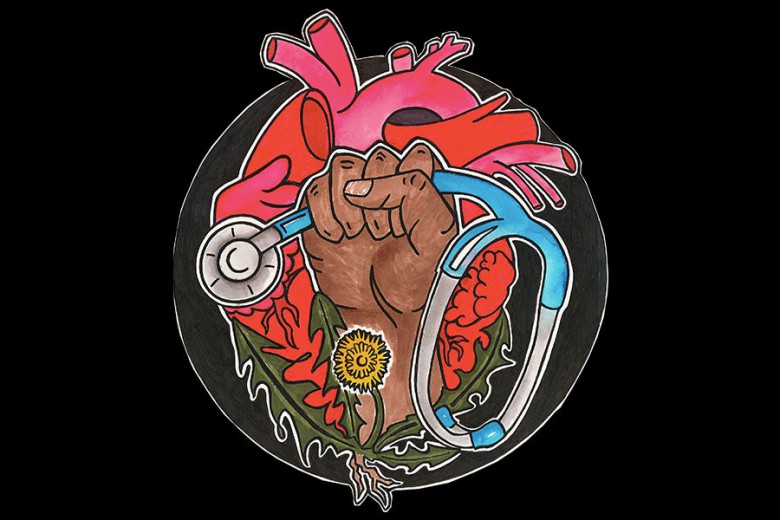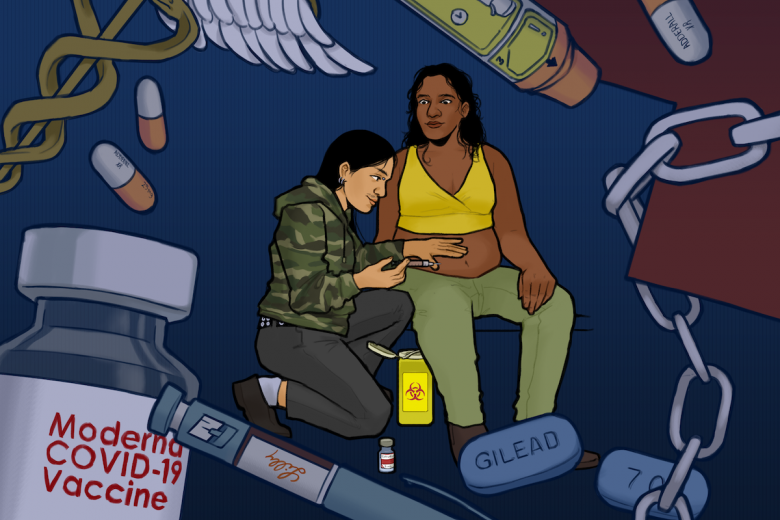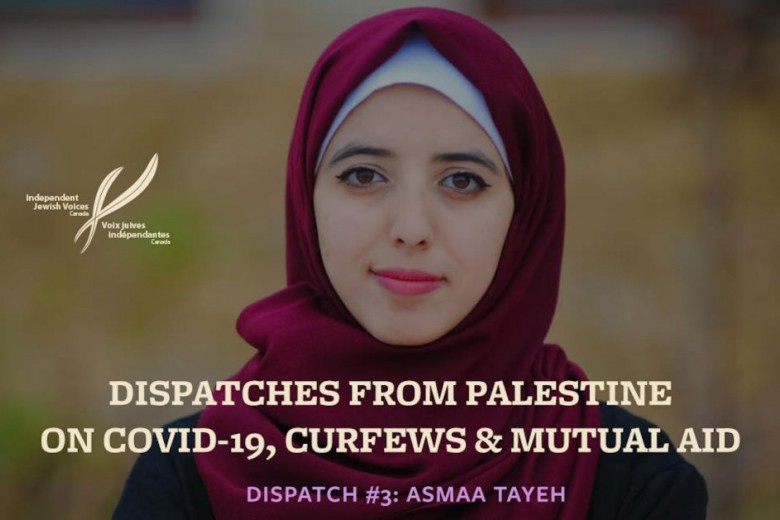This article was the winner of the 2019 Andrea Walker Memorial Prize for writing on women’s and non-binary people’s health.
On the first day of her nursing practicum at a long-term care facility, Jennifer Mallmes was tasked with bathing an elderly woman. It was silent when Jennifer entered the woman’s room and approached her bed. The elderly woman opened her eyes and asked Jennifer to brush her hair. Jennifer softly stroked the brush through the woman’s hair a couple of times. The woman said thank you, and then she died. Had it not been for Jennifer, she would have died alone in a dark, silent room.
In Canada, thousands of people die away from their homes and families in hospitals, hospices, and long-term care facilities each year. A disproportionately high number of them are women – 45 per cent of women die in nursing homes, compared to 29 per cent of men.
Women, historically branded as “caregivers,” provide 60 to 75 per cent of elder and life-limiting illness care. But when women themselves require end-of-life care, the central caregiving unit is down – women’s own needs are often considered secondary.
A disproportionately high number of them are women – 45 per cent of women die in nursing homes, compared to 29 per cent of men.
“I was angry for having been put in that position,” Mallmes recalls. “I was angry at the family for not being there. I was angry at myself for not having known what more I could have done for the woman in her final moments.”
After that pivotal day, Mallmes chose not to pursue nursing. “I left nursing school and began a journey to study death, dying, and seniors,” Mallmes explains. Having studied gerontology and sociology at Simon Fraser University (SFU) in British Columbia, she now advocates for better quality end-of-life care in Canada and works as an end-of-life doula to support those who are dying and their families. Doulas establish relationships with dying people and create opportunities to speak about the processes of dying, death, and last wishes. Mallmes also provides end-of-life education programs for others to fill what she calls the “gaps in the medical and social services fields around end of life.”
A new frontier
In 2012, nearly one in seven Canadians was 65 and over. By 2030, that number will increase to nearly one in four.
The demand for end-of-life care has grown with Canada’s aging population and the increase in chronic illness. With that, the need for improvements in care has grown, too.
Palliative care – one stream of end-of-life care – has long been defined as specialized medical care for patients and families dealing with chronic and life-limiting illness. Providers manage patients’ pain and stress, support families, and coordinate with doctors – creating comfort while trying to maintain the patient’s dignity. In 2016, a private member’s bill demanded the creation of the Framework on Palliative Care in Canada. The bill was in part a response to Canada’s changing demographics, but it was equally fuelled by people’s desire to have more options and autonomy in their final days – including choosing alternative holistic practices.
Despite being a comfort-focused approach, palliative care is still heavily clinical and medicalized. “Our medical system is great – so great [that] it creates the opportunity to put death on hold,” says Mallmes.
Profiteering from death
In 2015, the father of Kelly Ogilvie, an emergency room physician at Vancouver General Hospital, was battling dementia in Ontario. Relying on the public health-care system, he waited over two years to be accepted into a long-term care facility while Ogilvie’s mother struggled to care for him herself, cover medical equipment rentals out of her own pocket, and eventually navigate the challenges of having a different home care provider each day. “They didn’t know my dad, they didn’t know the routine,” Ogilvie says. She recalls that one of the hardest parts of their end-of-life experience, as a family, was “having him at home for way, way longer than he needed to be because we couldn’t get him into care.”
Hospice palliative care provided in a hospital is usually covered by provincial health-care plans. As Ogilvie’s father experienced, this kind of care tends to be hard to access and is impersonal even when it’s attained – but at least it’s financially accessible. However, as the population ages and long-term care wait-lists bloat – for example, exceeding 34,000 in Ontario – more and more people are opting for private home care and care facilities.
One of the hardest parts of their end-of-life experience, as a family, was “having him at home for way, way longer than he needed to be because we couldn’t get him into care.”
Public end-of-life care is being eroded at a higher level, too. Premier Doug Ford, for example, has been flirting with privatizing Ontario’s health care, proposing to create a new health “super agency” that would be able to demand hospitals contract out services to private companies. The list of services includes home care and palliative care. Ford has also proposed setting health-care funding at less than the rate of inflation and general demographic growth, ignoring the expected aging population. It would ensure that demand for services will vastly outstrip what the public system can provide, creating an almost certain recipe for future cuts and further privatization.
Since 2010, federal spending on health has more or less plateaued – eroding both the accessibility and quality of public health care and opening the door to growing privatization. But privatization is not a real solution to low-quality end-of-life care; it will always be a partial solution, available only to the wealthy. Instead, we need to focus on what can be done to make public end-of-life health care more personalized and accessible.
Part of the answer may lie with people like Jennifer Mallmes. End-of-life doulas have recently begun to gain popularity as a complement to palliative care, one that resists the medicalization of death. Doulas provide non-medical support to people who are dying and to their families, offering accompaniment, guidance, and resources. Mallmes notes that “[d]oulas also take the burden off of family members who may be left questioning what a loved one would want.” Doulas then can provide some relief from the “caregiver burden” that so often falls on the shoulders of women family members.
But end-of-life doulas are not yet covered by public health care and are rarely covered by insurance, so those seeking services usually have to pay out of pocket – and costs can range from $60 to $80 per hour. The new Framework on Palliative Care in Canada recognizes doulas in its “Measures to Support Palliative Care Providers and Caregivers” section but doesn’t go any further than a one-sentence acknowledgement. But it’s a start. Sharon Harper, director of policy at Health Canada explains: “The engagement and consultations we did in the creation of the Framework allowed us to identify and raise awareness about existing innovations and best practices that are already being used.”
But privatization is not a real solution to low-quality end-of-life care; it will always be a partial solution, available only to the wealthy. Instead, we need to focus on what can be done to make public end-of-life health care more personalized and accessible.
There is already a road map for integrating holistic care providers into Canada’s public health system. After all, it was only in 1991 that Ontario became the first province to regulate midwifery – a similarly woman-dominated profession that was long considered inferior to the depersonalized hospital care provided by a doctor. Today, midwives are regulated in the majority of Canadian provinces and their services covered by provincial health care. And while midwives continue to struggle for pay equity, birth doulas are not covered by universal health care, and Prince Edward Island and the Yukon still don’t regulate midwives, it shows that a widespread desire to move away from the depersonalization of care can bring big changes to policy and funding.
Making public funding a reality begins with raising awareness about the end-of-life doula profession. Sarah Kerr is a “death doula” in Calgary and told Maclean’s in a 2015 interview that she mostly built her company, Soul Passages, through word-of-mouth referrals and social media advertising. Today, Soul Passages has over 8,000 followers on social media and has been featured in a number of national publications. Kerr is also a member of end-of-life and “deathcare” activist groups on Facebook, consisting of members from all over the world sharing stories and inquiring into how to access end-of-life doula services.
In 2016, Mallmes founded the end-of-life doula certificate program at Douglas College in B.C.; the program has since been offered in Ontario, New Brunswick, and Nova Scotia. This success laid the foundation for the End-of-Life Doula Association of Canada; today Mallmes is the organization’s co-director. The association is currently self-regulated, but its goal is to have doula services regulated in all Canadian provinces and to secure public funding through increased federal palliative-care funding, or to have private doula care covered by medical service plans. The association liaised with health authorities and the Canadian Hospice Palliative Care Association for recommendations in creating their scope of practice, and its members attend community events – such as the Surrey Hospice Society’s annual forum – as often as possible to host interactive workshops. “We are letting others know who we are and what we do – how this can be a win for clients, families, and the health-care system,” Mallmes says.
Death, mapped
Quality end-of-life care depends on the availability of resources and infrastructure. This is vastly influenced by geography.
Lacey Jacobson, a registered nurse with Alberta Health Services, recalls how her mother lived in DeBolt, a hamlet in northern Alberta, and was diagnosed with dementia. When she finally needed 24-hour care, she was moved to an acute care facility in Grande Prairie because home care was not an option in DeBolt, nor was there a hospital or long-term care facility nearby.
Grande Prairie is a hub city for the surrounding rural and remote communities. Many of the women in care have been moved from the rural communities where they grew up, and where they were used to caring for large families on farms or acreages. “These women worked hard every day of their lives. Dementia was reverting them to the past when they used to drive a horse and buggy; now they [are] in a strange facility doing nothing but watching the news about things they have never heard of. That had to be a very confusing and overwhelming way to live out the final days of your life,” Jacobson says.
In Jacobson’s mother’s case, Nav-CARE could have enabled her to spend more of her final days at home – rather than in an unfamiliar place plunked in front of a TV.
Grassroots initiatives are growing to fill these gaps in rural communities. Barbara Pesut, a professor in the school of nursing at the University of British Columbia who researches palliative care in rural communities, and a group of volunteers have championed Nav-CARE, an organization that helps seniors in rural areas with chronic illness stay in their homes longer. Nurse navigators connect with seniors early – often before patients even consider themselves palliative – and pair them with specially trained volunteers to provide psychosocial support, guidance, and access to resources their clients might not have known of. In Jacobson’s mother’s case, Nav-CARE could have enabled her to spend more of her final days at home – rather than in an unfamiliar place plunked in front of a TV.
Nav-CARE survived the post-pilot-funding crash that many grassroots organizations experience, and is currently funded by the Max Bell Foundation and the Canadian Institutes of Health Research (CIHR), Canada’s federal funding agency for health research. Pesut explains that private foundations provide funding for pilot projects, “[but] when it comes to operational funding with those projects over time, it’s typically the health regions that have to step up to the plate.”
Cultural considerations
One evening, Aimee MacPhail, an emergency room nurse at Surrey Memorial Hospital, performed CPR on a patient in cardiac arrest. Later in the night, as the patient was dying, their family members gathered. It was then that MacPhail noticed a bundle of herbs on the dying patient’s bed. Curious, she contacted the hospital’s social worker and learned the bundle was for smudging – and also that it was unlikely the ritual would be allowed due to hospital policy. MacPhail and other nurses on shift cleared the hospital’s family room – the only place the sprinklers could be turned off – so the family and their Elder could smudge without setting off the smoke alarm. Staff respectfully removed the patient’s tubes and let the family be.
For Indigenous communities across Canada, colonization has resulted in the wiping out or suppression of cultural end-of-life care practices. It has also led to a surge in earlier-than-anticipated end-of-life needs. Intergenerational trauma, residential schools, and systemic racism in the health-care system have contributed to Indigenous people dying at higher rates than settler Canadians, as well as Indigenous communities having higher rates of chronic illnesses like diabetes. A lack of infrastructure and access to culturally safe care often results in folks being transferred to hospitals. There, traditional pain medicine and treatments – such as porcupine, soap berries, and the inclusion of a large extended family in the circle of care – are replaced with opioids, codeine, and strict visitation rules.
That is, if care is even received. In 2008, Brian Sinclair from Sagkeeng First Nation died alone in the emergency room of Winnipeg’s Health Sciences Centre, Manitoba’s most prominent hospital. He was ignored by staff for 34 hours, who claimed they did not see him, in his wheelchair, in the waiting room. Sinclair died directly from complications of an untreated bladder infection – and indirectly from racism. There was an inquest into Sinclair’s death, but policy changes have still not been implemented. These embedded racial and cultural end-of-life barriers have often resulted in the end of life for Indigenous people.
There, traditional pain medicine and treatments – such as porcupine, soap berries, and the inclusion of a large extended family in the circle of care – are replaced with opioids, codeine, and strict visitation rules.
Income inequality and communication constraints can also bar access to end-of-life care resources. Poverty and language barriers disproportionately affect immigrant women in Canada. In Ontario, a study found that a lack of end-of-life care resources for immigrant groups resulted in more immigrants – especially recent South Asian immigrants – dying in intensive care units (ICUs) and receiving aggressive medical end-of-life treatment than Canadian residents.
Health organizations are beginning to invest in more systemic solutions. British Columbia’s First Nations Health Authority – where I work – created a Declaration of Commitment on Cultural Safety and Humility in Health Services, which B.C.’s Ministry of Health, Provincial Health Services Authority, and all five regional health authorities have signed.
Indigenous death practices include rituals like smudging and brushings, traditional medicines, and guidance to journey into the spirit world. Jackie Jack, of Mowachaht/Muchalaht First Nation, says: “We all have our certain traditional jobs in our families and mine is to deal with death.” Jack is fluent in traditional medicines, as her grandmother’s eldest sister passed on that knowledge to her. “It’s part and parcel of who my family has groomed me to be. We never really talked about [it] – things just happened. This is the path that was laid out for me.”
“We all have our certain traditional jobs in our families and mine is to deal with death.”
The First Nations Health Authority recently partnered with Douglas College to train members of 47 First Nations communities in the end-of-life doula certificate program. Jack completed the program and is now a certified end-of-life doula. However, she notes that one of the largest barriers dying people face in accessing the services of a doula is that they are not covered by public health care and many of the families do not have “extra funds.”
Publicly funding end-of-life doulas could provoke a cultural shift, gently nudging society to move away from fast-paced, medicalized end-of-life care. Doulas naturally integrate holistic approaches into Western medicine and provide services that are not rooted in medical interest.
The shadow on the wall
Kelly Ogilvie often sees end-of-life conversations starting in the emergency room. “Families haven’t discussed their dying family member’s wishes. […] They have not made a code decision [on whether a person should be resuscitated if their heart stops beating],” she says. Often a “quantity over quality” approach is taken: do everything to keep individuals alive for a few more days, or even hours. “People do not understand what do ‘everything’ means,” says Ogilvie. “Running a full code is aggressive and invasive. It strips away all dignity.”
Western culture and medical institutions forestall death. Approximately 70 per cent of people die in hospitals and 25 per cent of health-care costs occur in the last year of life. For the elderly and terminally ill, quality of life greatly diminishes during this time, as those in hospitals often receive invasive and costly treatments. The new Medical Assistance in Dying law, which allows a doctor or nurse to consensually assist a person in dying, provides another option.
Canada’s Criminal Code, which made assisted suicide and euthanasia illegal, was first challenged in 1993 by Sue Rodriguez, a B.C. woman with ALS. The courts ruled against her, but the battle was reignited during the 2014 Carter v. Canada trial on behalf of two B.C. women, Kay Carter and Gloria Taylor, who suffered life-limiting illnesses. This time, the courts ruled with Carter to uphold the values of autonomy and dignity, and MAiD was legalized in 2016.
“People do not understand what do ‘everything’ means,” says Ogilvie. “Running a full code is aggressive and invasive. It strips away all dignity.”
So why do trends toward medicalized, forestalled death continue? Planning for death and providing end-of-life care is counterintuitive. We spend all of our days trying to live, and health-care providers are trained to keep people alive – death is viewed as a failure.
MAiD and end-of-life doulas are flipping this narrative. “Not everyone is okay with medically assisted death [MAiD],” says Jack. She explains that part of her role as an end-of-life doula is to ensure the patient has all the information they need to make an informed choice on how they want to go. “If a person chooses MAiD and someone in their family is against it, an [end-of-life] doula can step in and say, ‘No, here are the forms – this is their wish.’”
Many individuals do not know how to approach death or find it too difficult to see their loved ones at death’s door – all the more reason it is critically important to give death the presence and attention it deserves. Traditional gender norms – which constitute women as caregivers and position many of them to die alone – have taken a prominent role in the changing landscape of end-of-life care. Women provided 80 per cent of the development feedback in the creation of the Framework on Palliative Care in Canada and were the sole gender participating in the trials for MAiD. It was clear that women had something to say.
Public funding and grassroots initiatives are vital to continue to improve end-of-life care. But what we really need is a national-level introspective exercise to address this reality: the longer we wait to accept death, the less likely it is that we’ll get to experience the death we want.







